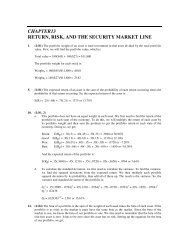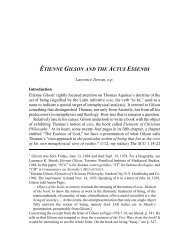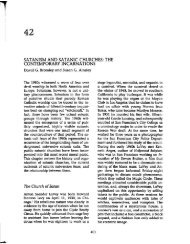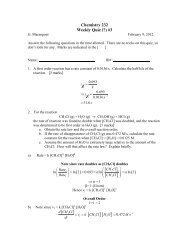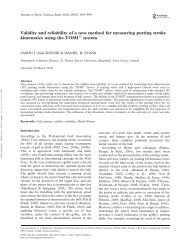Coca chewing and high altitude stress.pdf - StFX Faculty and Staff ...
Coca chewing and high altitude stress.pdf - StFX Faculty and Staff ...
Coca chewing and high altitude stress.pdf - StFX Faculty and Staff ...
Create successful ePaper yourself
Turn your PDF publications into a flip-book with our unique Google optimized e-Paper software.
peninsula on the western frontier [Patifno 1967:202; Plowman<br />
1981:199]):<br />
Bray <strong>and</strong> Dollery: COCA AND ALTITUDE STRESS<br />
They all keep their mouths filled with a certain green herb which they<br />
ruminate, in almost the same manner as animals, so that they are<br />
hardly able to utter a word. Also, around their necks they all of them<br />
carry two dried calabashes, one filled with the herb which they have<br />
in their mouths, <strong>and</strong> the other with a certain white flour like powdered<br />
plaster, <strong>and</strong> with a little stick which they moisten <strong>and</strong> chew in<br />
the mouth, <strong>and</strong> frequently dip into the flour calabash, they take out<br />
enough to sprinkle on both sides of the herb which they carry, an<br />
operation which they repeat frequently <strong>and</strong> very slowly.<br />
to Chile <strong>and</strong> from sea level to the <strong>high</strong> Andes. Since the region<br />
from Colombia northward is outside the area of Inca influence,<br />
this wide dispersion is not simply a consequence of Inca expansion.<br />
<strong>Coca</strong> <strong>chewing</strong> can therefore be expected to show a long<br />
history of indigenous development all over this vast region.<br />
Archaeological evidence corroborates this view.<br />
THE ARCHAEOLOGICAL EVIDENCE FOR COCA<br />
Observations spanning the next few decades attest to the<br />
habit among the Nicarao of Pacific Nicaragua <strong>and</strong> all along the<br />
CHEWING<br />
Caribbean coasts of Venezuela <strong>and</strong> Colombia. Of the Indians Archaeology demonstrates that the 16th-century pattern outin<br />
the Caracas area, Juan de Pimentel wrote in 1578: "they say lined above has considerable antiquity. Most of the finds of<br />
that it takes away hunger <strong>and</strong> thirst, <strong>and</strong> gives them strength actual coca leaves are from the arid coasts of Peru <strong>and</strong> Chile,<br />
to work, <strong>and</strong> so they use this hayo [the local name for coca] where organic materials are well preserved; elsewhere the eviwhen<br />
they work or have to walk" (Patifno 1967:203).<br />
dence is indirect, taking the form of stone or pottery represen-<br />
For inl<strong>and</strong> Colombia the 16th-century documents make it tations of coca chewers <strong>and</strong> examples of the paraphernalia (lime<br />
clear that coca <strong>chewing</strong> was widespread all over the country containers, dippers, spoons) associated with coca taking.<br />
<strong>and</strong> at all <strong>altitude</strong>s, from the Sinfu lowl<strong>and</strong>s (Castellanos 1955 In coastal Peru, coca <strong>chewing</strong> first appears in the late Pre-<br />
[1598]) through Antioquia <strong>and</strong> the middle Cauca Valley at ceramic period. At Culebras, on the central coast, Engel (1957:<br />
around 1,000-2,000 m (Cieza de Leon 1971 [1554]) to the 67-68) excavated two burials (one of them a female) accom-<br />
Muisca kingdoms of the altiplano at over 2,500 m (summarized panied by a gourd vessel <strong>and</strong> three Mytilus-shell containers<br />
in Patifio 1967 <strong>and</strong> Perez de Barradas 1950-51:42-64) <strong>and</strong> filled with powdered lime. The Culebras site should be dated<br />
southward to Popayan <strong>and</strong> to Pasto on the Ecuadorian frontier. somewhere around 2000 b.c. <strong>Coca</strong> leaves are found at Anc6n,<br />
Of the warrior tribes of the Magdalena Valley, Vargas Machuca in the Chill6n Valley, between 1800 <strong>and</strong> 1400 b.c. (Cohen 1978:<br />
commented in 1599 that they could keep going for three days 125), <strong>and</strong> coca-like leaves (variety unspecified) <strong>and</strong> powdered<br />
on coca alone <strong>and</strong> also chewed it to keep awake when they were lime came from the site of Asia, in the Omas Valley of the<br />
on sentry duty.<br />
south-central coast, with a radiocarbon date of 1314 + 100 b.c.<br />
The abundant information on coca <strong>chewing</strong> in Inca territory (Engel 1963).<br />
need not be repeated here, but the data from another lowl<strong>and</strong> For the ceramic period, evidence is abundant from all parts<br />
area-the Amazon Basin-do require some consideration of the coast. At Huancayo Alto, in the chaupiyunga zone (i.e.,<br />
(Plowman 1981). Here coca may be chewed as a quid (e.g., the coca-producing zone, between 600 <strong>and</strong> 2,000 m above sea<br />
among the Mashco [Califano <strong>and</strong> Fern<strong>and</strong>ez Distel 1977]) or level) of the Chillon Valley, Dillehay (1979) tested a group of<br />
taken as a snuff (Schultes <strong>and</strong> Holmstedt 1968:119; Schultes storage structures dating somewhere between 800 <strong>and</strong> 200 B.C.<br />
1981), but it is more often ingested in the form of a powder The main products stockpiled for distribution were maize, coca,<br />
made from toasted leaves. To this powder is added an alkaline <strong>and</strong> marine shell. From the midvalley plantations, the leaf was<br />
substance, usually an ash made from the wood, bark, or leaves presumably traded to both <strong>high</strong>l<strong>and</strong>s <strong>and</strong> coast, for coca was<br />
of certain trees or lianas (Holmstedt et al. 1979; Schultes 1981; found at the contemporary coastal site of Garagay with pottery<br />
Plowman 1980, 1981). <strong>Coca</strong> may also be taken with tobacco resembling that of Huancayo Alto (Dillehay 1979:31 n. 17).<br />
snuff (Califano <strong>and</strong> Fernf<strong>and</strong>ez Distel 1977) or tobacco concen- From Tembladera, in the Jequetepeque Valley of northern<br />
trate (Uscategui Mendoza 1954:283). The combination of coca Peru, comes a Chavinoid effigy pot representing a figure with<br />
<strong>and</strong> tobacco is not confined to Amazonia. The Indians of the a quid in its cheek <strong>and</strong> dated ca. 500 B.C. (Jones 1974:4, 7).<br />
Sierra Nevada de Santa Marta take tobacco concentrate with Another effigy jar, this one clearly showing the lime dipper, is<br />
their coca (Uscategui Mendoza 1954:273; Reichel-Dolmatoff attributed to the Lambayeque Valley <strong>and</strong> is dated around the<br />
1949-50:79), <strong>and</strong> some archaeological coca bags from south- time of Christ (Jones 1974:4).<br />
coastal Peru, dating from Nazca to Inca times, contain a mix- For the last 1,500 years before the Conquest, the evidence<br />
ture of coca leaves <strong>and</strong> what appears to be tobacco, though this from coastal Peru is too abundant to discuss in detail. There are<br />
latter identification has yet to be confirmed by analysis (Rost- numerous representations of coca chewers on Moche <strong>and</strong> Nazca<br />
worowski de Diez Canseco 1973:205).<br />
pottery; Rostworowski de Diez Canseco (1973) notes a series<br />
It is still uncertain whether coca <strong>chewing</strong> has a long history of coca bags in the Ica museum ranging from Nazca to Inca<br />
in Amazonia or is an introduction from the Andes in late pre- periods in date; Towle (1961) <strong>and</strong> Jones (1974) list a selection<br />
Hispanic or colonial times as Uscategui Mendoza tends to of finds, of all periods, from the south <strong>and</strong> central coasts. If we<br />
believe. All one can say is that the custom was recorded over a had to rely on archaeological evidence alone, we could conclude<br />
wide area at the time of first European contact. Patinlo (1967: -not necessarily correctly-that coca <strong>chewing</strong> was more<br />
214-17) notes that the Cofanes were cultivating coca by 1560- ancient <strong>and</strong> widespread on the coast than in the Andes.<br />
70 <strong>and</strong> that it was used by the tribes of the Rio <strong>Coca</strong> in 1662, Farther north, in coastal Ecuador, there is a late Valdivia<br />
in the Ambiyacu region near the Amazon confluence in 1740,<br />
<strong>and</strong> at the confluence of the Purfus <strong>and</strong> Amazon Rivers in 1774.<br />
figurine of ca. 1600 B.C. depicted with a quid in its cheek <strong>and</strong><br />
also a series of Valdivia lime pots which push the history of coca<br />
In the 1774 account, the Indians reported that the coca kept <strong>chewing</strong> back beyond 2000 B.C. (Lathrap, Collier, <strong>and</strong> Ch<strong>and</strong>ra<br />
them awake through nocturnal ceremonies. On botanical 1975:48, 79). Inl<strong>and</strong>, in the Jubones Valley at about 1,000 m,<br />
grounds, Plowman (1981:210) believes that the development<br />
of Amazonian coca as a distinct cultigen must have preceded<br />
the first European reports by several centuries, <strong>and</strong> the myunpublished<br />
excavations by Bray <strong>and</strong> Elizabeth Carmichael<br />
have produced miniature lime-encrusted pots in Machalillarelated<br />
deposits, one of which has a radiocarbon date of 1231 ?<br />
thology of various tribes of the northwestern Amazon attributes 53 b.c. (BM-912). From the early centuries A.D. to the Conto<br />
the plant an ancient <strong>and</strong> supernatural origin (Schultes 1981, quest, a group of poorly dated pottery figurines <strong>and</strong> lime pots<br />
Plowman 1981).<br />
from the coastal provinces of Manabi <strong>and</strong> Esmeraldas extends<br />
In summary, the ethnohistorical evidence indicates that, at the documentation to the whole of the Ecuadorian coast<br />
the time of European contact, coca was used from Nicaragua (Saville 1910: pl. 92.5; Jones 1974: 12; Lowe Art Museum 1981:<br />
Vol. 24 * No. 3 * June 1983 271



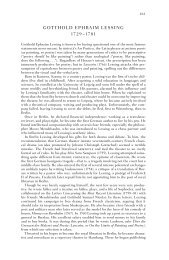

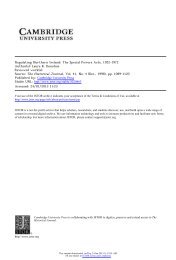

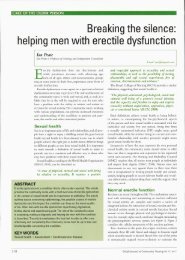
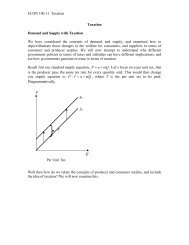
![The Rink - Cyril Dabydeen[1].pdf](https://img.yumpu.com/21946808/1/155x260/the-rink-cyril-dabydeen1pdf.jpg?quality=85)

